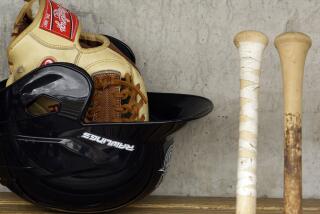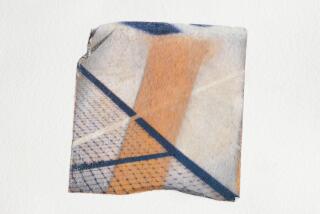Space-Age Techniques Applied to Sports Gear
David Fernandez’s hobby is sailing. He’s one corporate executive who has never played golf or tennis. Although there are no rules against that, the choice of sports is somewhat surprising in his case: Fernandez is the founder of a company that uses space-age technology to make high-priced tennis rackets and golf club heads.
The personal preference has proven to be no professional barrier, particularly for someone who studied nuclear engineering at the University of Chicago and worked in the aerospace industry on materials that can withstand great stress.
Fernandez, a 45-year-old Midwesterner, is president of Dasia Corp., a little outfit in Camarillo that uses technology of the sort developed for the National Aeronautics and Space Administration’s space shuttle program to make sporting goods that are sold under some of America’s best-known labels.
Dasia hopes the promise of high performance and the lure of high technology will persuade affluent aficionados to lay out $3,000 for a set of golf clubs or $300 for a tennis racket, even when there is nothing wrong with the ones they already own.
A Tough Racket
But high-end, high-tech sporting goods can be a tough racket. Until recently, Fernandez’s main business was American Sports Equipment Inc., an 8-year-old Camarillo concern that grossed $5 million to $10 million a year making graphite tennis rackets--it sold more than 150,000 of them over the years--for such companies as Slazenger and Prince.
That was until imports made a shambles of the graphite-racket game a couple of years ago. So, in March, 1983, Fernandez and partner Walter Keller, a Westwood tennis pro, formed Dasia to exploit new technologies, pursuing what is by now a time-honored strategy in many fields for combatting inexpensive imports. American Sports Equipment is now “dormant,” Fernandez said.
Dasia seems not to have done badly so far. Fernandez said the firm has a contract worth a minimum of $2 million in 1986 with Fila, the Italian sportswear company, to be the sole distributor of Fila-brand sporting goods and accessories worldwide, including ceramic tennis rackets and golf club heads. The rackets go on sale in January.
Dasia also has begun selling ceramic golf club heads to MacGregor, Wilson, Cobra and Titleist, Fernandez said. Carl Pickard, Wilson’s golf marketing director, said his company’s Dasia ceramic-head driver will sell for about $200, roughly double the average cost of the company’s drivers.
Patents Pending
He said patent applications are pending on several of Dasia’s ceramic products and on its ceramic technology. The ceramic itself is purchased from Minnesota Mining & Manufacturing, Fernandez said.
Unfortunately for Fernandez and Keller, the Japanese apparently are no strangers to ceramics. Yamaha Sporting Goods, based in Buena Park, will not only beat Dasia to the market with a Japanese-made ceramic tennis racket, but its product will sell for less than half of what Dasia’s racket will retail for under the Fila name.
Yamaha also is starting to sell golf clubs with ceramic heads that will be less expensive than Dasia’s. The clubs are made in Singapore and assembled in the United States.
But Dasia says its rackets are better--Yamaha disputes that--and it is aiming its new Fila Astroceramic rackets--Challenger, Discovery, Enterprise and Columbia, all named for space shuttles--at an elite group of consumers. The same goes for the golf clubs.
Fila products will be sold at existing Fila boutiques, as well as elsewhere, Fernandez said. Fila’s shops are in affluent communities such as Beverly Hills and La Jolla.
Makers of ceramic sporting goods say the material is lighter, stronger and more durable than alternatives such as graphite, wood or metal. Ceramic golf club heads are also harder, imparting more force to the ball and absorbing less themselves, they say. And ceramic offers tremendous design flexibility.
Dasia used computers to design its new ceramic products with great precision, Fernandez said. He has worked with ceramics before. At Fansteel in Newbury Park, he worked on the development of ceramic body armor for the military. Fernandez also worked on ceramics at Aerojet General in Azusa.
The company manufactures its products at its plant in Camarillo, where it has about a dozen employees. Some labor-intensive aspects of the work, such as polishing finished golf club heads, are done by another 25 Dasia employees in Mexico, Fernandez said.
High-Tech Image
The image Dasia’s customer companies are striving for, however, is strictly high-tech. Fila, for example, promotes the new Astroceramic rackets in photos showing one with a model of the space shuttle.
But whether ceramic really is any better--or perhaps more important, whether it is worth the added cost--is itself the subject of debate. Some critics are doubtful that ceramics will be such a big improvement. They say it is more of a marketing gimmick than anything else in a business in which products are generally so durable that there is little need for them to be replaced.
Even Wilson marketing director Pickard acknowledges that probably only the best players will notice much difference.
“There’s a certain segment of the golfing population, what they want is the finest, newest, highest-tech equipment,” he said. “It’s something different, and they want to be different.”
More to Read
Inside the business of entertainment
The Wide Shot brings you news, analysis and insights on everything from streaming wars to production — and what it all means for the future.
You may occasionally receive promotional content from the Los Angeles Times.










